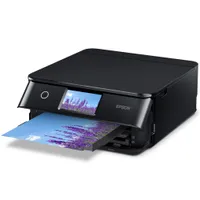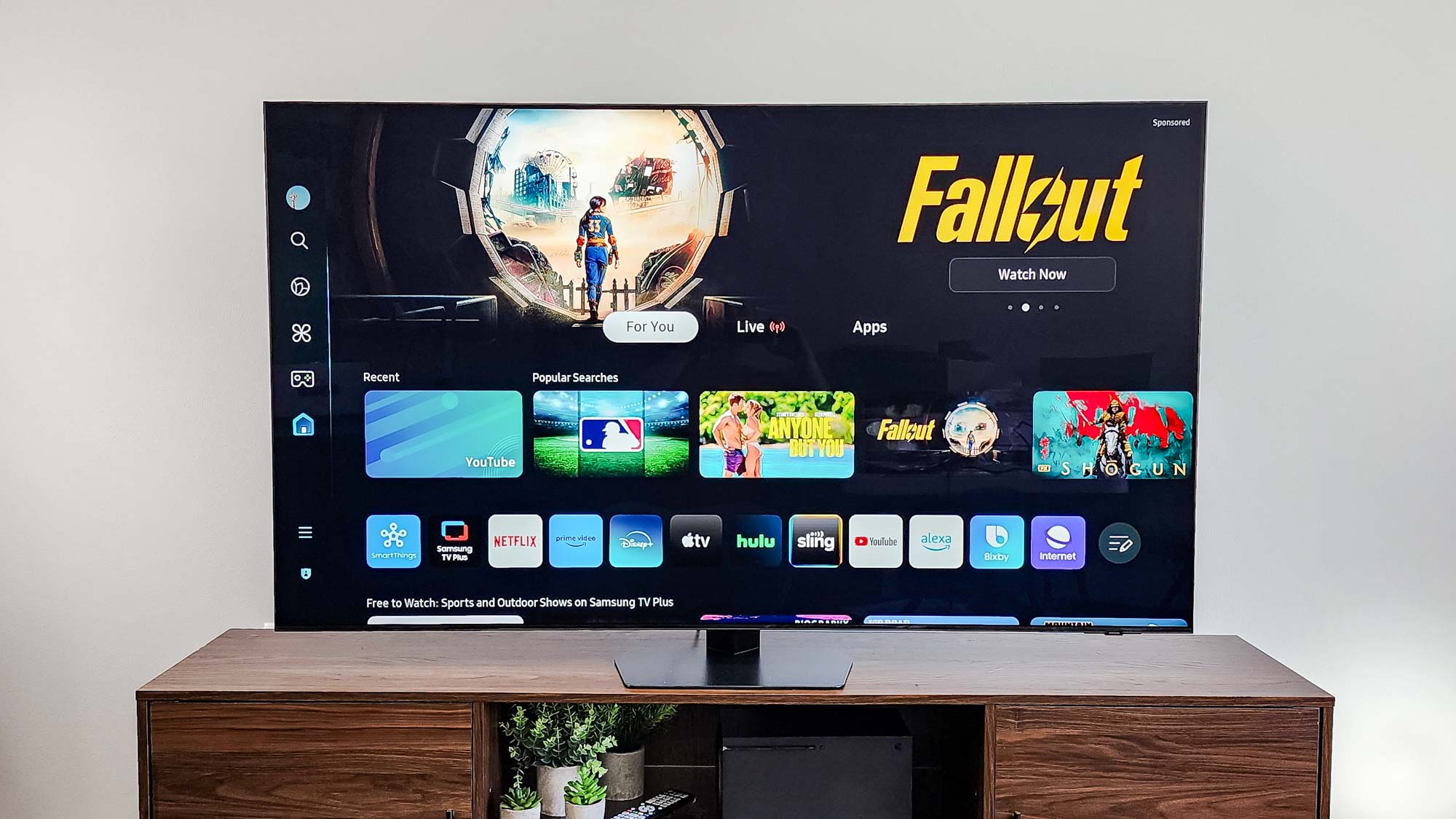The best printers in 2025: our top picks tested and rated
These are the best printers we recommend based on our testing and reviews
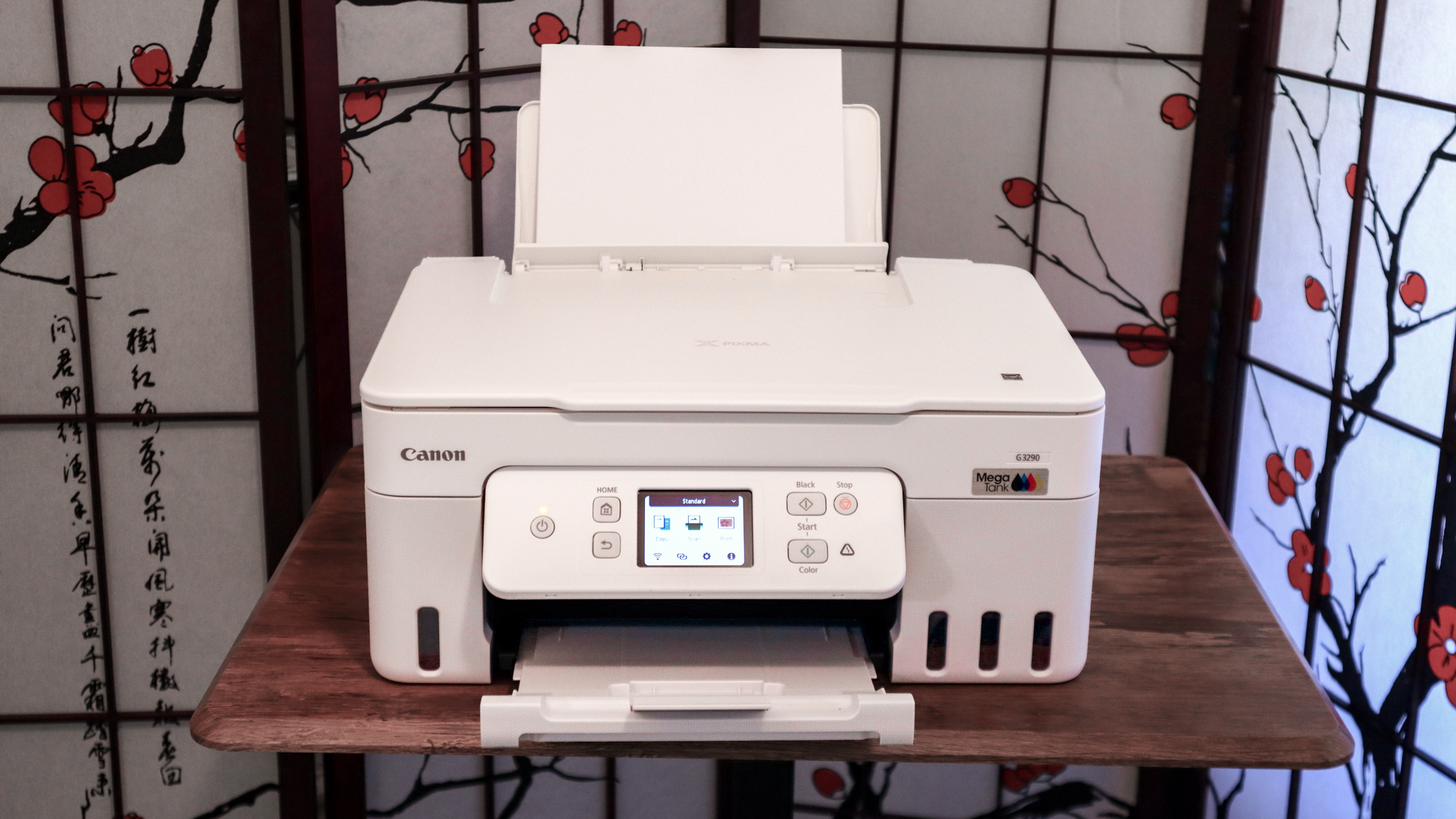
The world is pretty digital these days, but some of us still need to print stuff out—and when you do you don't want to deal with messy prints, runaway ink costs and terrible interfaces.
I know because I help oversee our printer reviews here at Tom's Guide, so I've learned more than I ever thought there was to know about how every printer we review prints, scans and copies. If you've read any of our printer reviews you know we put every model through a rigorous series of tests to see how fast, capable and affordable they are, then I hand-pick the best of the best to put on this list.
Based on our testing I typically recommend the Brother INKvestment MFC-J995DW as the best printer for most readers because it offers great print quality with low ink costs.
It's also not too expensive, but if you want something cheaper I suggest the Canon MegaTank Pixma G3290 instead because it's an affordable all-in-one with low ink costs. However, if photo printing is what you care most about I recommend the Canon Pixma TR8620 because it's the best photo printer we've tested to date.
Read on for more recommendations and explanations, including detailed information on ink levels and printing performance (based on our in-depth testing process) so you won’t have to sweat as much about running low on ink at a bad time.
The quick list
In a hurry? Here's a quick list of the best printers we recommend.
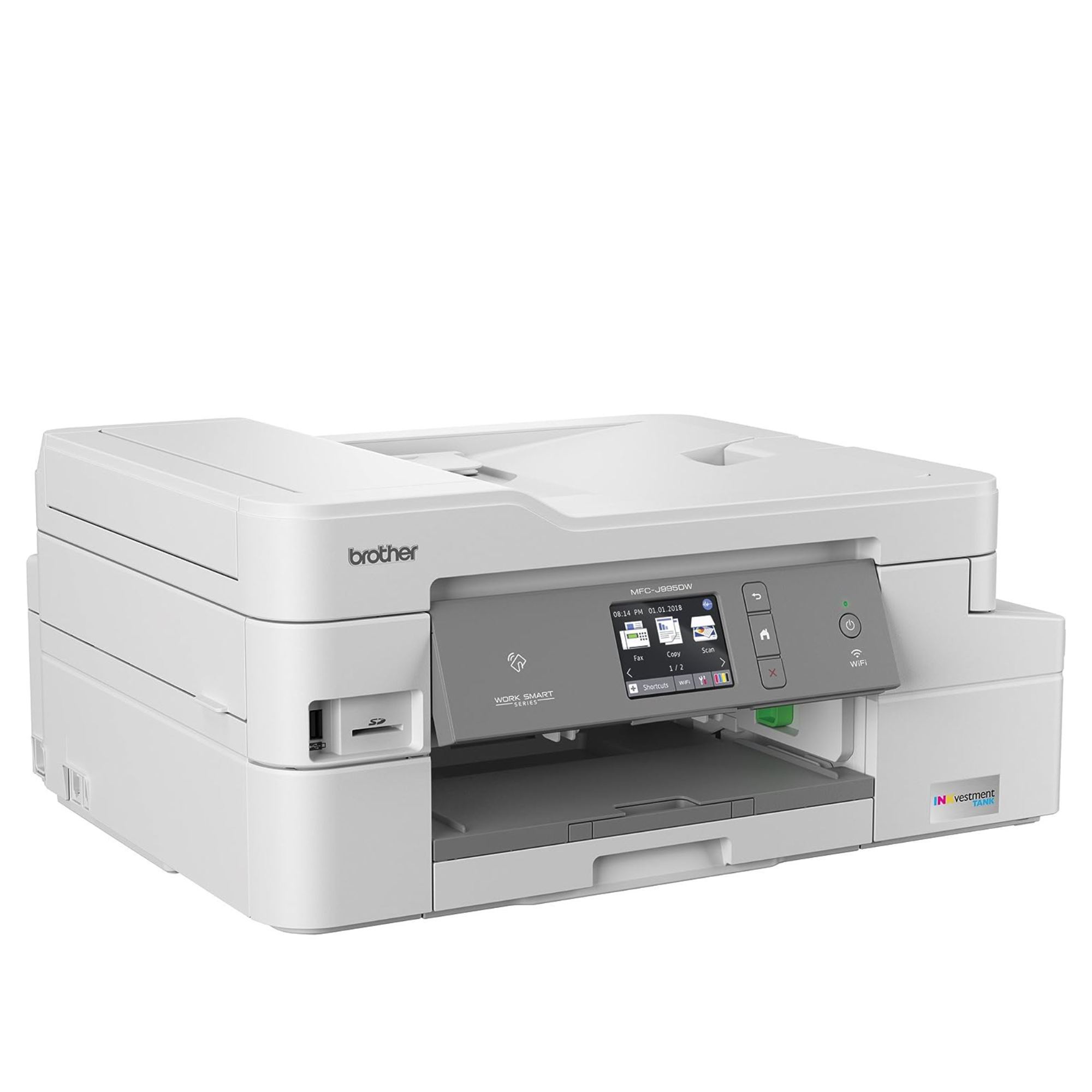
If you want one of the best home printers with the most affordable ink, we recommend Brother's INKvestment MFC-J995DW. This all-in-one inkjet offers large ink cartridges and solid printing, scanning and copying performance as well as a year's supply of ink included.
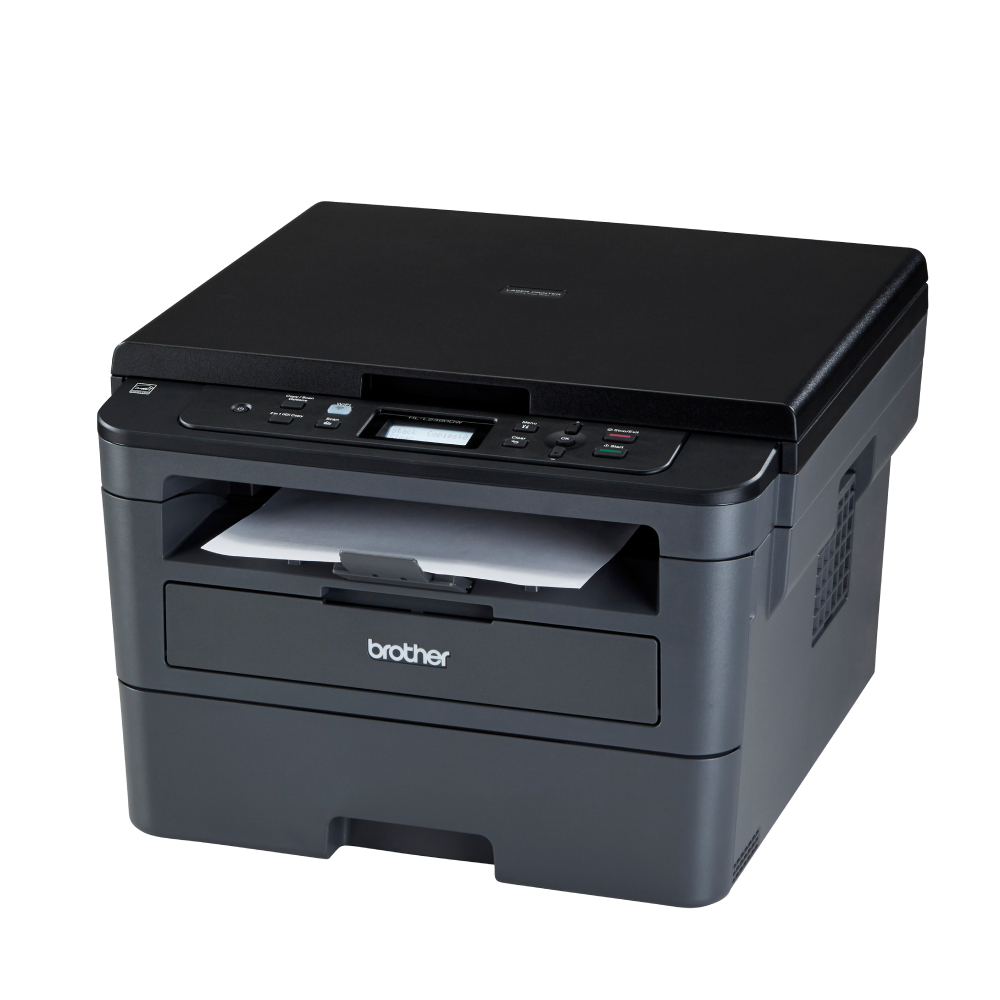
The Canon MegaTank Pixma G3290 is an affordable all-in-one that delivers great prints with low ink costs. What it lacks in frills it more than makes up for in affordability and reliability.
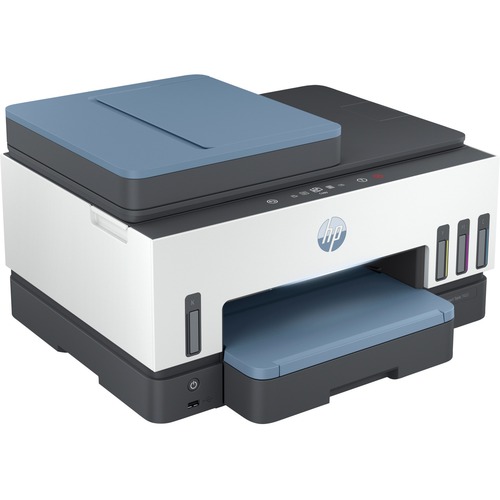
The HP Smart Tank 7602 is a speedy multifunction wireless printer that's a solid performer with low ink costs, which is why we recommend it as the best student printer for most. Just be ready for some slow, frustrating software, which any college student should be able to handle with no trouble.
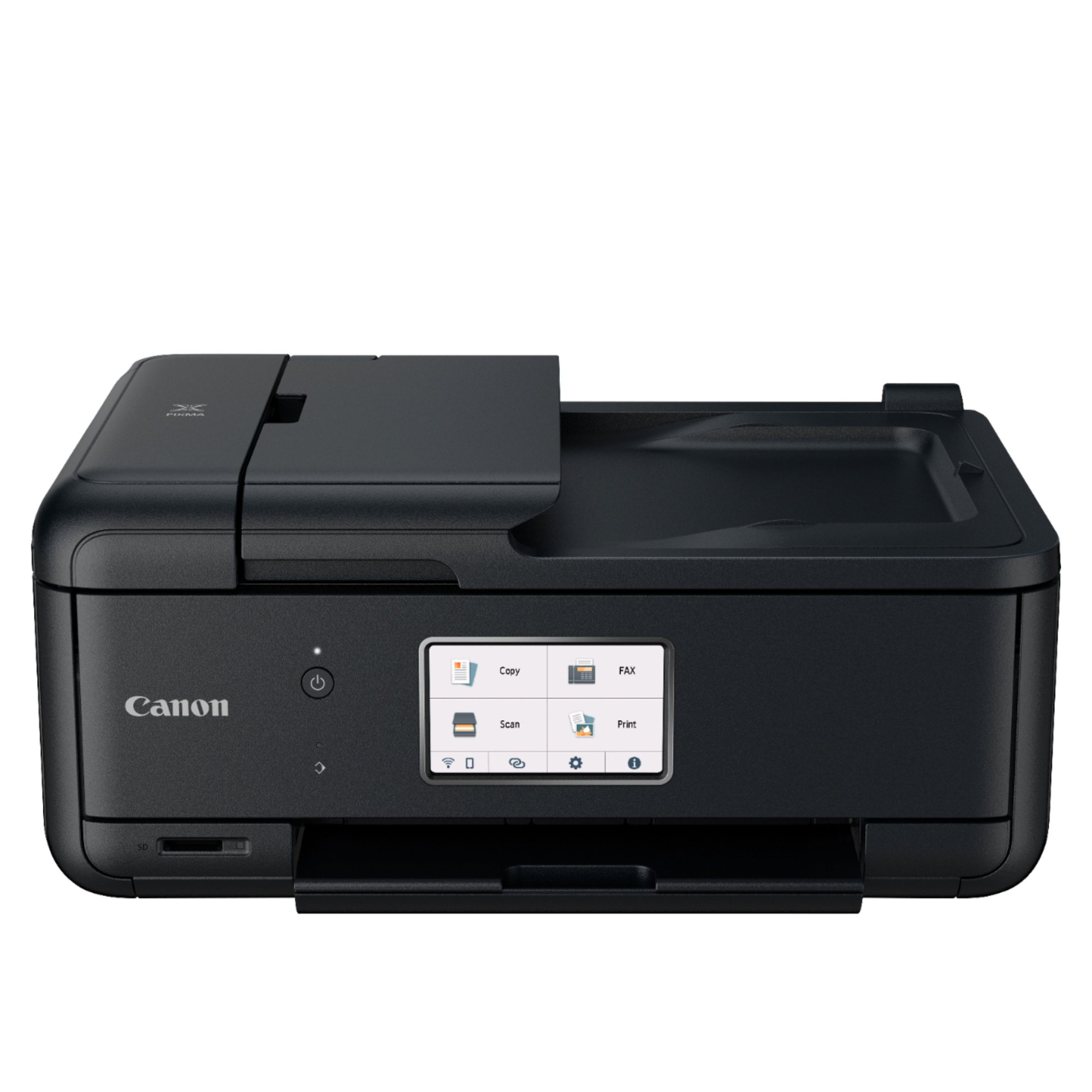
The Canon Pixma TR8620 is a great home printer that we recommend as the best photo printer most often because it prints high-quality images fast, without costing an arm and a leg. If you want something more portable, consider the Pixma TR150 below.
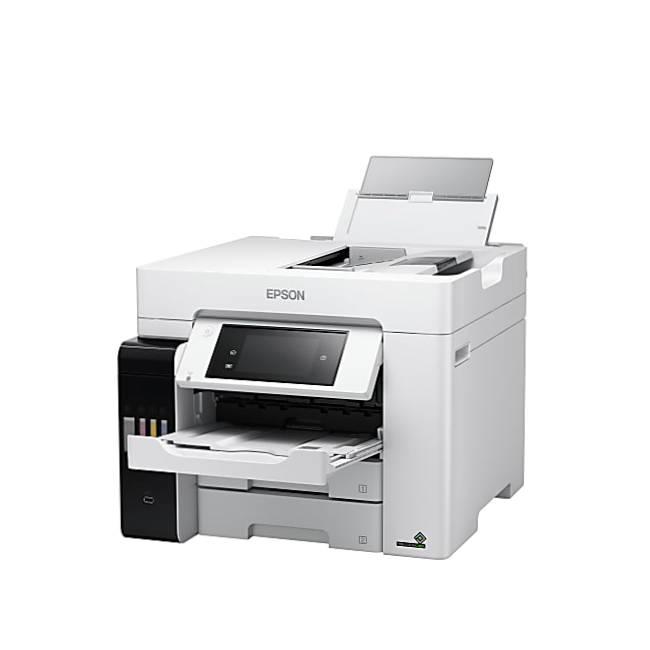
The Epson EcoTank Pro ET-5850 is the printer we recommend for home offices and small businesses because it prints well, uses refillable ink tanks to keep costs down and comes with a suite of business-friendly features like a duplexer and multiple print trays.
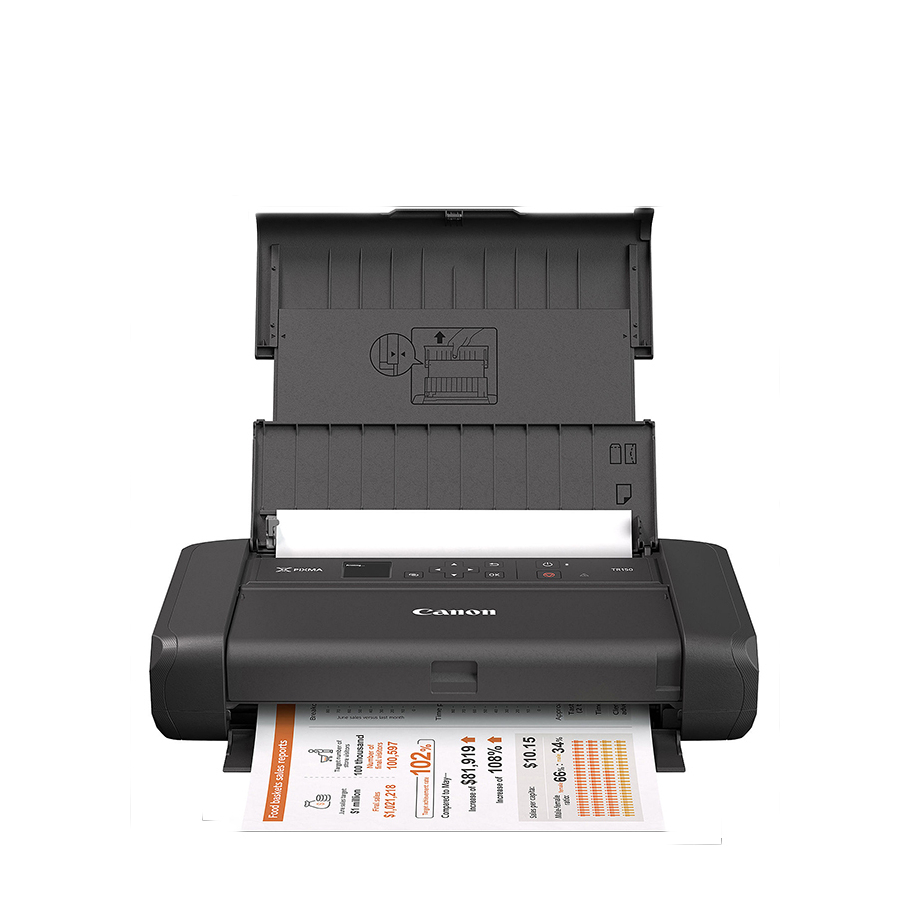
We recommend the Canon Pixma TR150 if you want a great portable photo printer because it cranks out everything from 4x6 photos to page-sized prints, yet fits in a backpack and uses low-cost ink. The only drawback is you can't copy or scan.
The best printers you can buy now
Why you can trust Tom's Guide
The best printer overall
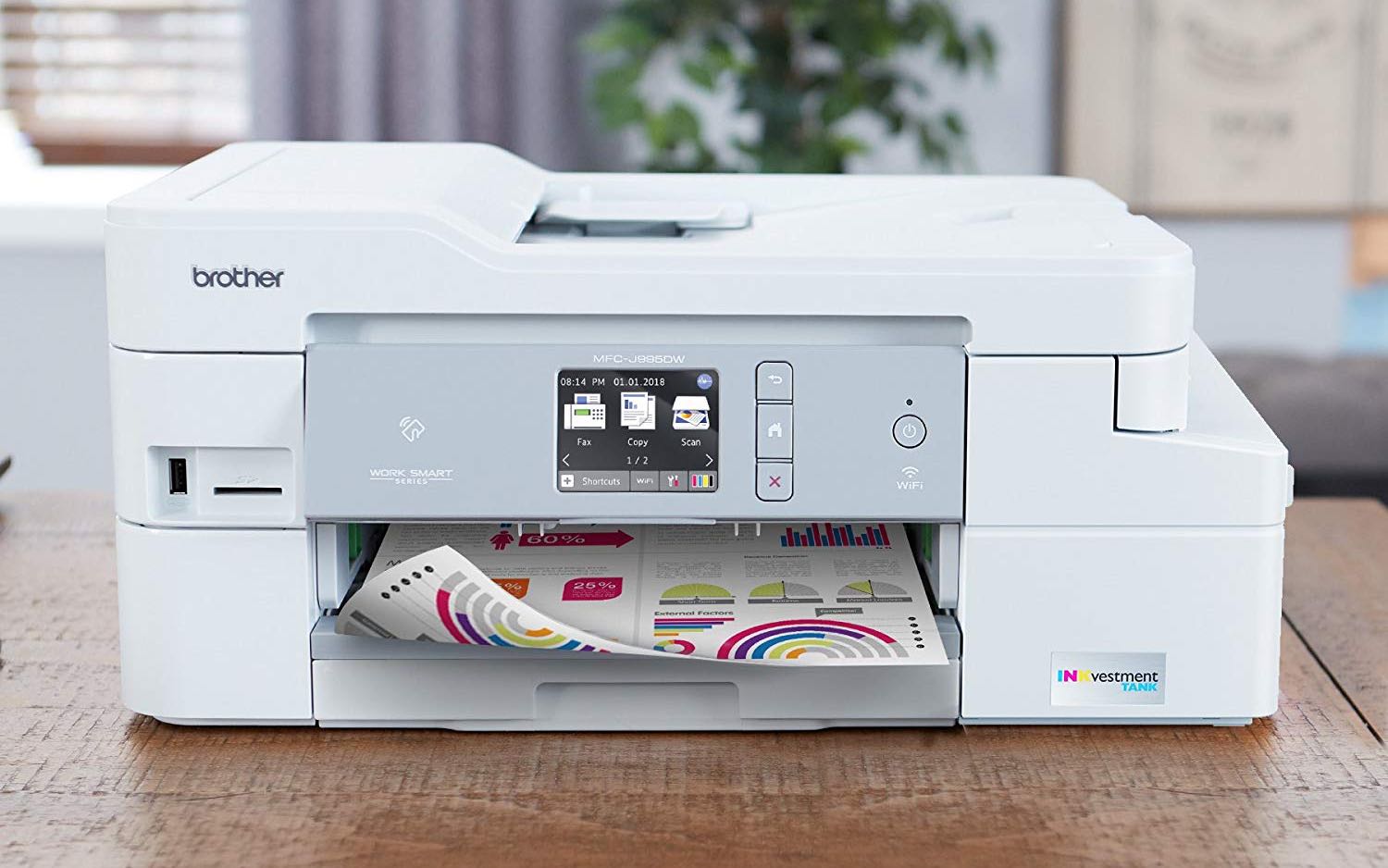

Specifications
Reasons to buy
Reasons to avoid
Sure, it's a bit of a mouthful, but we keep recommending the Brother INKvestment MFC-J995DW as the best printer overall for most folks because of its winning combination of fast print speeds, good print quality and low print cost.
Of course, there's much more to the cost of a printer than just the purchase price: Ink costs can eat away the savings you expected from your affordable device. But even though we keep testing new models of printer, we keep coming back to the same truth: if you want one of the best home printers with the most affordable ink, get the Brother INKvestment MFC-J995DW. This all-in-one inkjet printer offers extra-large ink cartridges, and comes with an estimated years' supply of ink in the box, which adds up to the lowest per-page ink costs we've seen.
On top of that, the Brother INKvestment MFC-J995DW offers solid printing, scanning and copying. Print speeds beat the category average and two-sided printing is among the fastest we've seen. And it did all of this while delivering high print quality across the board.
That same zippy speed and above-average quality was found in scans and copies, making it a great choice for anyone, even if you aren't buying it for the affordable ink.
Read our full Brother INKvestment MFC-J995DW review.
Best budget printer
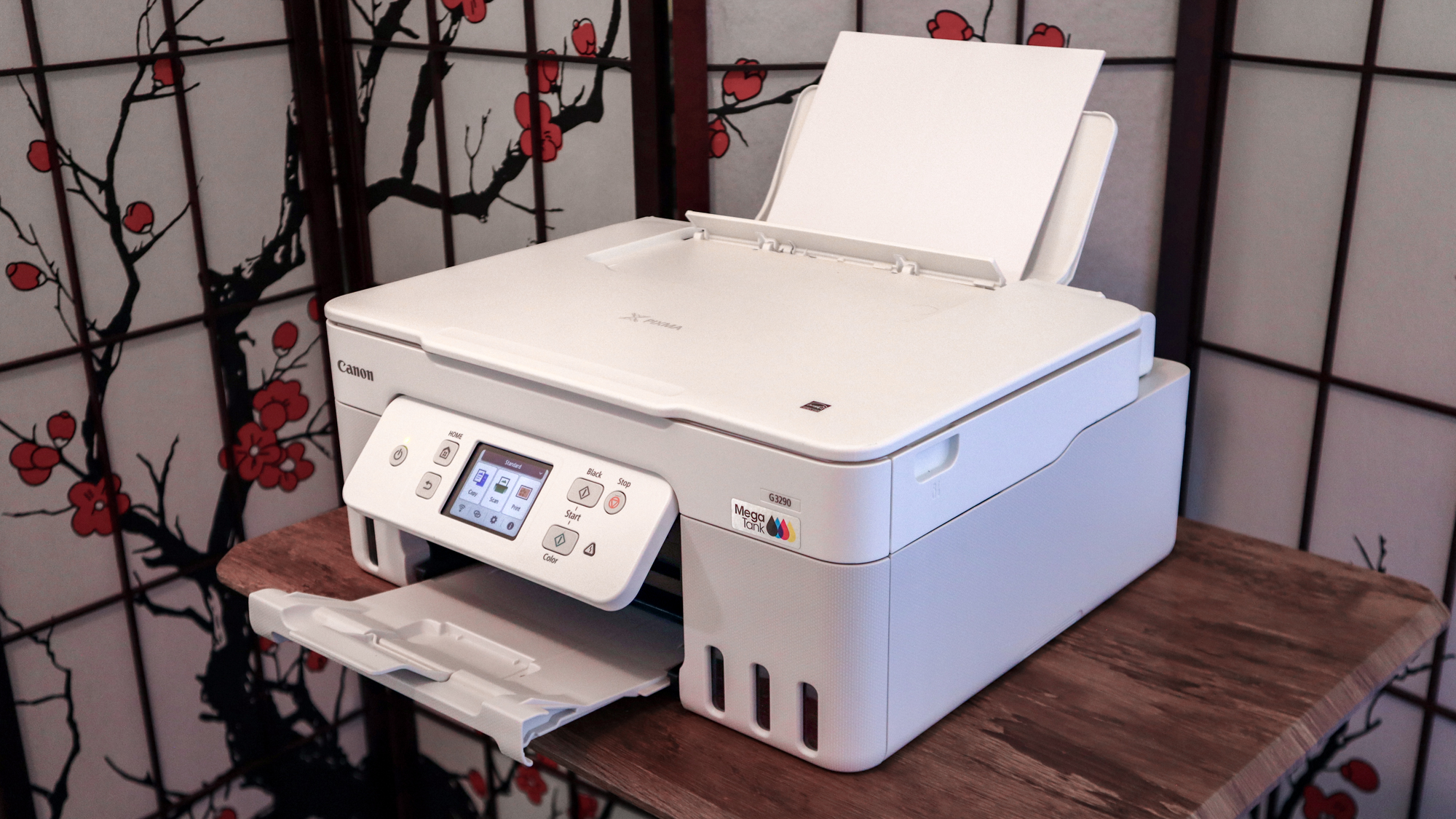

Specifications
Reasons to buy
Reasons to avoid
The Canon MegaTank Pixma G3290 is an ink tank all-in-one that delivers great prints with low ink costs and an affordable up-front price, making it my top recommendation for folks seeking a great budget printer.
Of course, you shouldn't expect a lot of bells and whistles on this entry-level all-in-one. It has no document feeder and only one paper tray, plus the speed of copies and prints is pretty average, so you won't be flying through big print jobs.
But if you don't need to be printing all the time, this is a great choice because it delivers what most of us are looking for in a great all-in-one: reliable, high-quality prints with the versatility to do documents, photos and double-sided print jobs.
In our testing this machine managed to print an average of 9.2 pages per minute, which is pretty on par with the competition. But when printing double-sided text documents that cranked up to 7.2 pages per minute, the fastest duplex print speed we've recorded of any recent ink tank printers.
And thanks to its easy setup process, robust wireless support (this thing can print via Wi-Fi, Bluetooth or a smartphone app) and low ink costs (we estimate color prints cost roughly 0.9 cents per page, significantly lower than the 1.9 cent per page category average) this is a great printer for anyone seeking a cheap, reliable ink printer for photos and documents.
Read our full Canon MegaTank Pixma G3290 review.
Best student printer
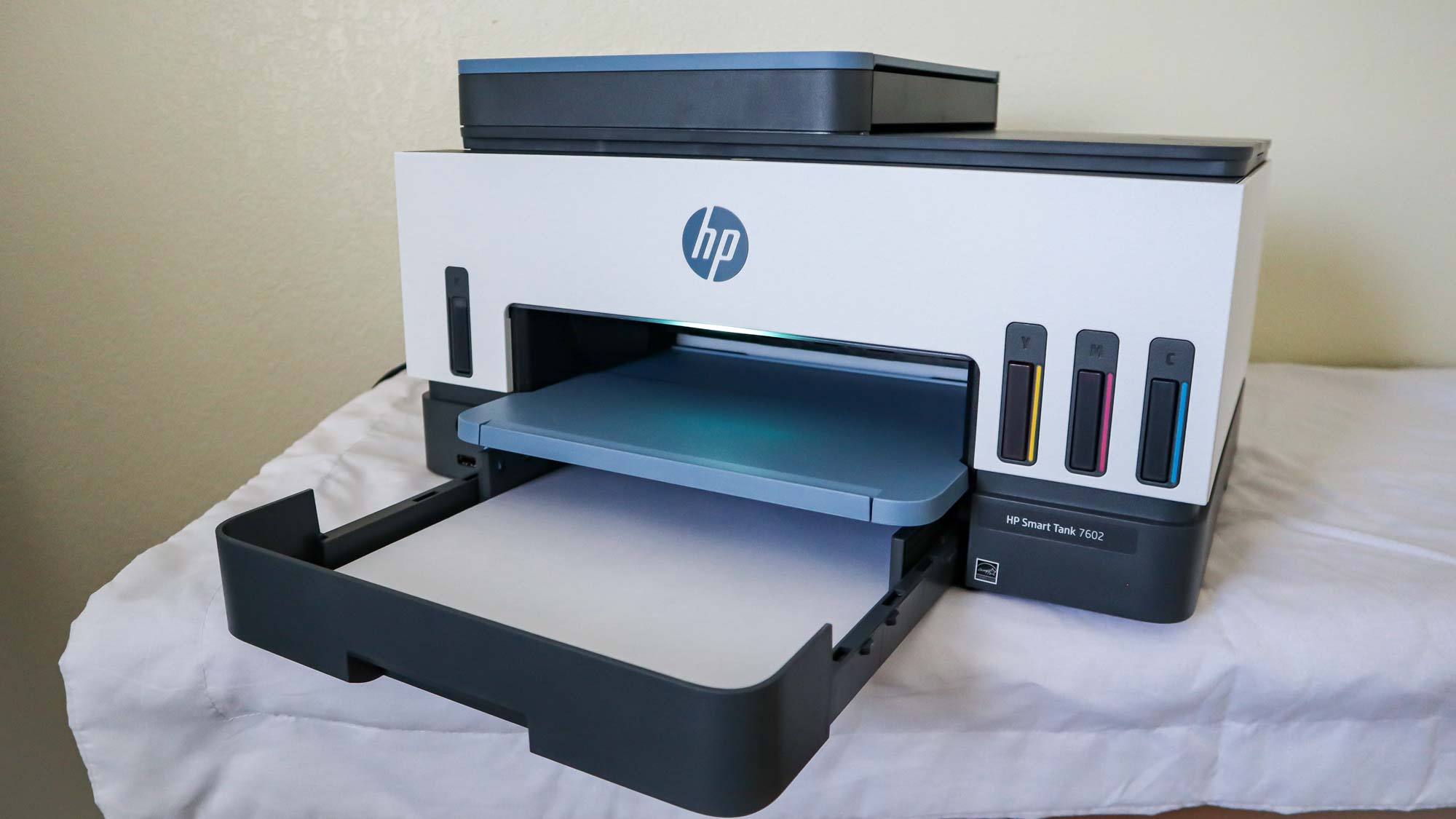

3. HP Smart Tank 760
Our expert review:
Specifications
Reasons to buy
Reasons to avoid
The HP Smart Tank 7602 is a wireless multifunction printer that we regularly recommend as the best printer for students (most of the time) because it's easy to set up and prints good-quality prints quickly, with very low ink costs.
I know because our printer expert exhaustively tested it himself in his own home, and the HP Smart Tank 7602 surprised him by printing an 8x-10-inch glossy photo at high resolution in under 2 minutes, which is more than twice as fast as the category average (4 minutes 1 second).
It also scans and prints quite quickly, and is speedy at kicking out color and black-and-white documents. However, printed scans often showed small discolorations and pixelations, so this isn't a great printer for photojournalism students or others who prize perfection in prints.
However, our reviewer definitely had some hassles when trying to set up the printer via its included HP Smart software. You can connect the printer to a PC via either USB, Wi-Fi or Bluetooth, and unfortunately you'll need a (free) HP Smart account to take full advantage of all the printer's features.
Still, despite these setup headaches this printer is our top recommendation for students because of its ease of use, good print quality and low ink costs.
Read our full HP Smart Tank 7602 review.
The best photo printer
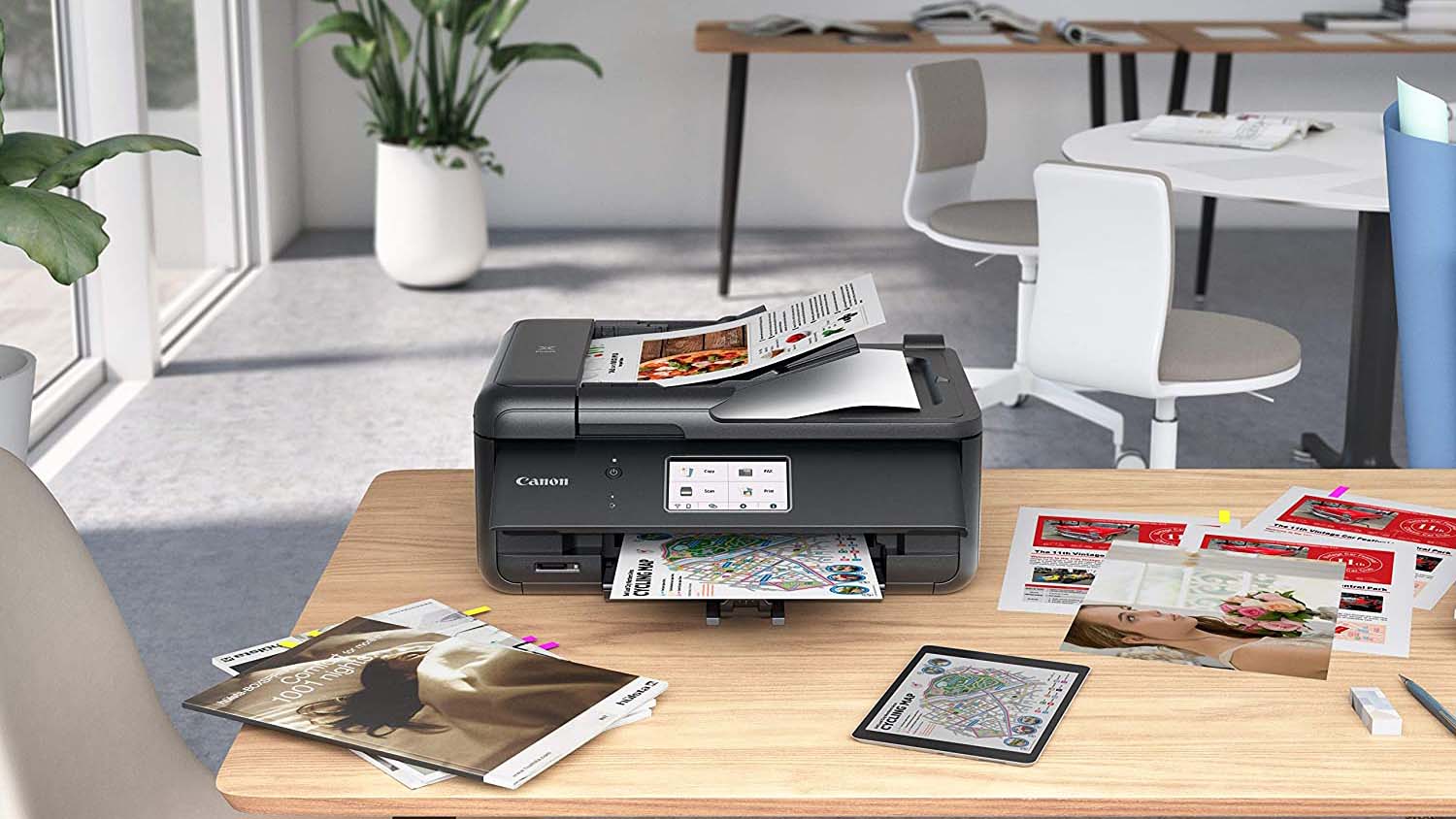

Specifications
Reasons to buy
Reasons to avoid
The Canon Pixma TR8620 is a great home office printer that's ideal for use by students, families and home businesses. But we most often recommend it as the best photo printer overall because it prints great photos fast, with reliable quality.
It's also a great home printer, with faster-than-average print speeds and high print quality overall. Text and color graphics all look great, and our printer expert noted that glossy photos printed impressively fast, plus the use of a 5-ink cartridge system with two types of black ink resulted in photos with high-quality accuracy: Natural-looking colors, sharp details and smooth transitions.
Really, our only big complaint with the Pixma TR8620 is the above average cost of ink, due partially to the expense of the extra ink cartridge.
But the positives outweigh the negatives, especially because even when you're not printing photos this machine offers plenty of office features, from scanning and faxing to a 20-page automatic document feeder (ADF), a duplexer for two-sided printing, and two paper trays for keeping two types of paper at the ready. A big 4.3-inch color touchscreen makes it easy to control, plus the printer supports smart home integration with Amazon Alexa and Google Assistant for easy home use.
Read our full Canon Pixma TR8620 review or view our Canon promo codes
Best for small businesses
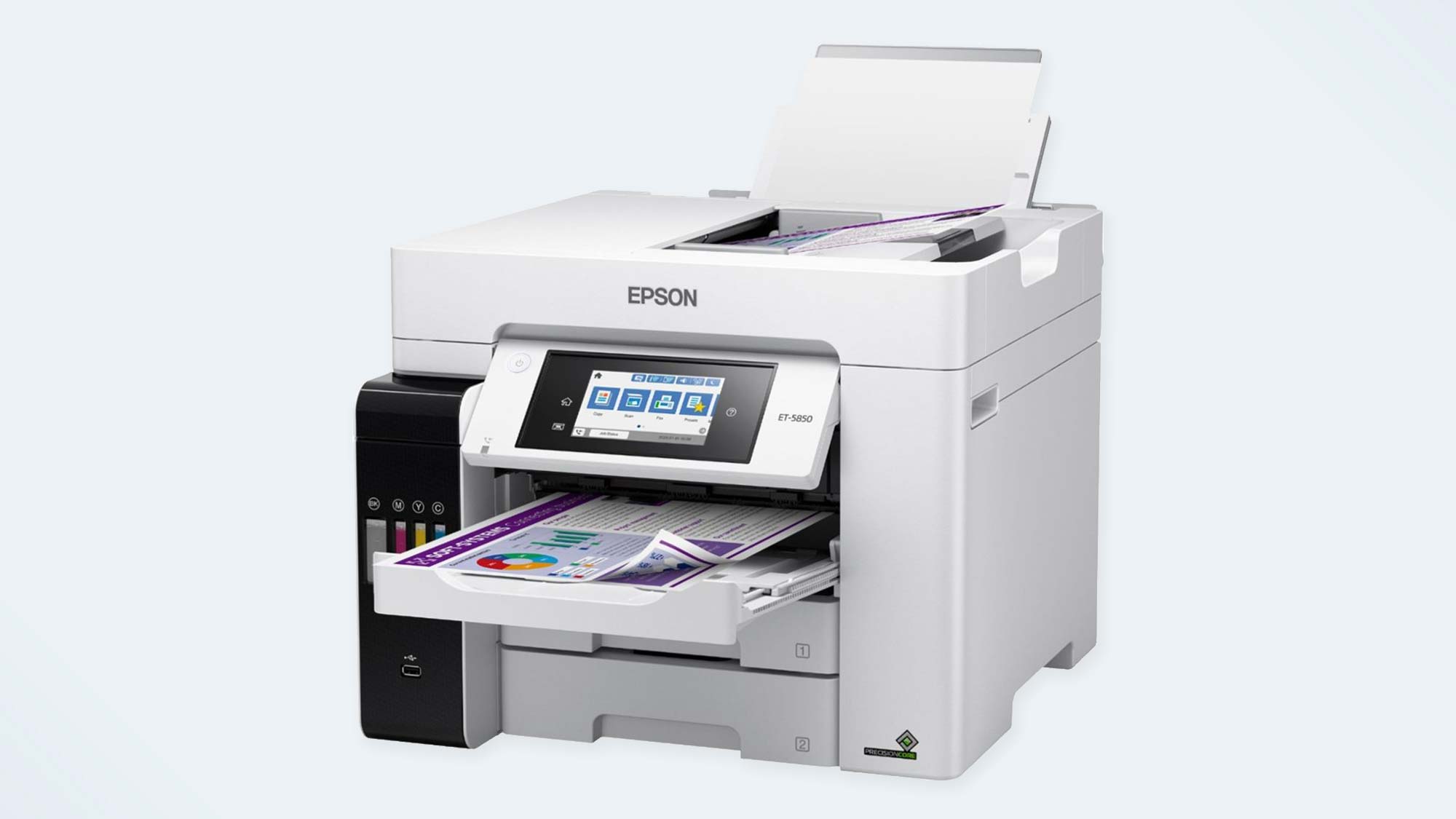

Specifications
Reasons to buy
Reasons to avoid
The Epson EcoTank Pro ET-5850 combines impressively low ink costs with an abundance of business-friendly features to take its place as the best small business inkjet printer we've reviewed. The EcoTank design uses refillable ink tanks and comes with enough spare ink bottles to print thousands of pages. A small business printer rated to print more than 3,000 pages per month, it's more than capable of handling whatever your team might throw at it. The printer boasts scan, copy and fax capability, dual 250-page paper cassettes, a 50-sheet automatic document feeder and a large, easy-to-use 4.3-inch touchscreen for convenient operations.
In timed printer tests, the Epson ET-5850 delivered some of the fastest printing we've seen, and produced crisp, clear text that nearly rivals laser printer quality. That same quick, high-quality performance was also seen in copying and scanning, making it the printer of choice for offices that need a full featured multifunction printer. But the real draw is the ink savings, extremely low per-page costs of 0.4 cents for text pages, and 1.6 cents per color page. The upfront price may be high, but the combination of quality, features and super-low operating expenses make this one of the best investments you can make for your office.
Read our full Epson EcoTank Pro ET-5850 review or view our Epson coupon codes
Best portable photo printer
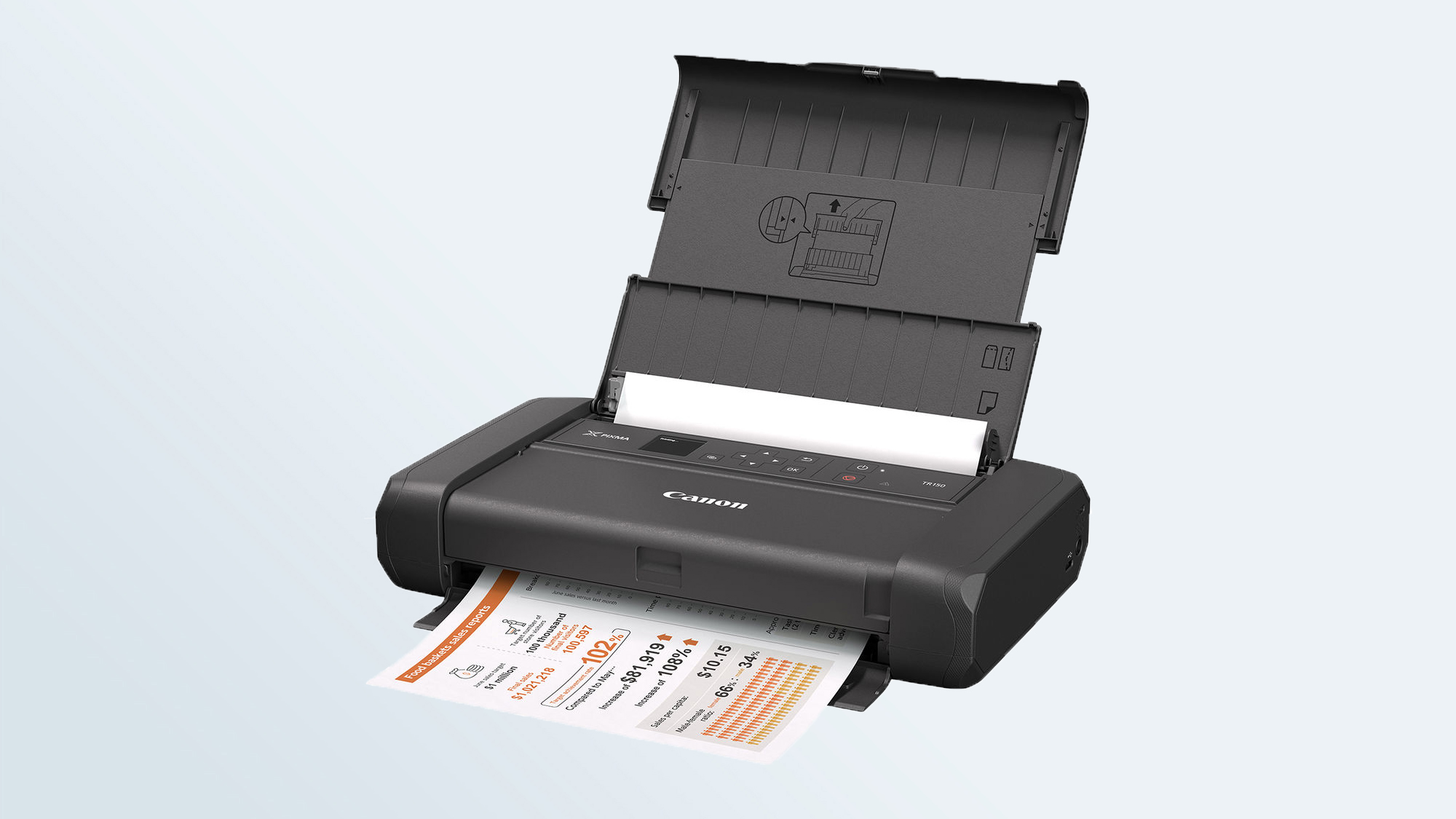

Specifications
Reasons to buy
Reasons to avoid
The Canon Pixma TR150 is a portable inkjet printer that's small enough to carry in a backpack, but big enough to print everything from 4x6 photos to 8.5 x 11 documents. With a two-cartridge system, its ink is affordable and lends itself well to a variety of printing uses. But where the Canon really stands out is photo printing.
The Pixma TR150 made high-quality photos faster than other competing portable printers, and delivered excellent color and detail. It can also handle larger photo prints, but unlike some of our photo printing favorites, there is no copy or scan capability. You do get a solidly built portable printer with optional battery and even support for Amazon Alexa and Google Assistant voice controls, but we love it for the great photos and low ink costs it offers.
Read our full Canon Pixma TR150 review.
Also tested
There are lots of other great printers out there that don't quite have what it takes to knock any of our best printers off their perch. But it's awful close, and when we test and review a printer that's nearly good enough to earn a spot on this list we add it to this Also Tested section to give you some extra options.
So while these printers weren't quite the best of the best, they're still great options for when you can't find your first pick on sale, or if you need a specific brand or feature.
Epson Expression Photo XP-8800 (★★★★☆)
This is a solid photo printer from Epson that delivers great photo prints quickly thanks to its 6-ink system and dual paper trays. However, it's typically over $100 more expensive than our best photo printer, so buy it if you need an upgrade over the Pixma or it's on a good sale.
Read our Epson Expression Photo XP-8800 review.
How to choose the best printer for you
Finding the right printer starts with defining what you need that printer to do. There's a drastic difference between a large multifunction printer that will copy, scan and fax and a pocket-sized photo printer that's perfect for printing snapshots on the go. The best place to start is to narrow down what functions you want, and what aspects of printing are most important to you.
Inkjet or Laser: Inkjet printers are generally better at producing the full range of colors, making them more suited for printing graphics and photos. Laser printers, on the other hand, can quickly produce professional looking text documents often at a lower cost per page.
All-in-One printers offer more than just printing, with built in scanners that can scan and copy everything from forms to photos. Some (but not all) will also have fax capability.
Photo printing is a separate concern, requiring support for printing on glossy paper, handling different photo paper sizes and sometimes requiring additional (and potentially expensive) inks to deliver better print quality.
Portable printing is all about mobility. Compact designs are paired with batteries and sometimes exotic print technologies to let you print from a hotel room, in your car, or even out at the beach.
In addition to the type of printer, you'll also want to pay attention to specific aspects of performance and operating expenses.
Print speed refers to how quickly the printer will complete a page in a document, measured in pages per minute. If you need to print frequently, or in high volumes, faster print speeds are a must have.
Print quality comes down to how well the printer lays ink on the page, and whether it produces sharp details and legible letterforms. Most inkjet printers deliver "good enough" levels of quality, but if you want crisp looking text every time, you'll probably want a laser printer. And photo printing varies widely between general use printers, so check out the recommended models on our best photo printers list.
Ink costs are an ongoing concern for any printer, since ink refills are part of the operating expenses for any printer. Ink can get very expensive, but some new models are designed to reduce both the expense and the hassle of finding the right ink cartridges. And this isn't purely an issue for inkjet printers, as laser printers use toner cartridges. Look for a lower cost-per-page and check out our reviews for a detailed discussion of how print costs might make one printer better than another.
Three ways to cut printing costs to a minimum include: Switching to a laser printer, opting for a tank-based inkjet printer, or signing up for a subscription ink service. (See our articles Inkjet vs. Laser: Which printer is right for you? and HP Instant Ink vs. Canon vs. Epson: Are ink subscriptions worth it? to learn more.)
Once you find the best printer in your desired category, you're ready to buy.
Frequently Asked Questions
Should I get a multifunction or single-function printer?
You may have noticed that printers come in all shapes and sizes, and the larger, more expensive ones tend to have at least one or two extra functions besides printing: scanning, faxing and high-speed copying are common features on pricey multifunctions like the Brother MFC-L2750DW.
But if you don't need all that extra functionality, it's typically not worth paying extra for a printer that has extraneous features you'll rarely use. And honestly, these days smartphone cameras are so good that you can get by just photographing paperwork and scanning/saving/signing/sending it via an app on your phone, so there's rarely a need for an individual to own things like a printer that faxes and copies. The Brother HL-L2390DW is our top budget pick, for example, and it includes no fax module—but most people won't miss that.
However, if you're buying a printer for a busy home office or small business, a high-quality multifunction laser printer like the Canon ImageClass MF743Cdw may be exactly what you need.
How do I find a deal on a printer?
Typically the best time to find a great deal on a printer is during major sales events like Memorial Day (in the U.S.), Black Friday and the many Amazon Prime Days.
In addition to keeping your eye peeled for great sales on our top picks, here are two key things I recommend you keep in mind to avoid spending too much on a new printer.
Avoid features you don't need: Check the printers you're looking at to make sure they offer every feature you need, and avoid those with features you don't. For example, there's no need to pay for a model with a second paper tray or a fancy touchscreen if you're only going to print things occasionally because you'll barely use those features.
Consider cost per page: Laser printer toner is typically cheaper than ink cartridges for inkjet printers, but the price can still add up. So once you pick the best laser printer for your needs, read our full review and price out the cost-per-page to see if you can save money by investing in a high-capacity toner cartridge.
For example, my top recommendation the Brother MFC-L2750DW XL prints for 3.75 cents per page, and the standard toner cartridge rated to last through 1,200 pages. But if you pay a bit more for a a high-capacity cartridge that cost drops to 2.7 cents per page, which can save you money over time.
For more tips and recommendations covering both laser and inkjet printer deals, check out our longer guide to how to find the best cheap printer for your needs.
How we test the best printers
Every printer we review is extensively tested to give us a clear idea of how well it performs, both in print capability, but also general ease of use and expense over time. Our testing procedures include timed print tests to determine print speeds, with a set of standardized documents that have a mix of text and graphics and color photos.
Every print is examined and compared, with errors and print problems noted in the review and overall quality measured against the other printers on the market.
We also test the scanning and copying functions (when they are offered), timing how quickly it captures a page and comparing the results to the original images to determine how well it captures color and detail.
To measure the cost of owning and operating a printer, we look at the current street price of ink refills and the estimated number of pages that each cartridge can produce, and calculate the cost for printing a single page.
These specific tests are adapted as needed to handle all sorts of printers, from monochrome laser printers and portable snapshot printers to full-featured all-in-one inkjets. Wherever possible, we make sure that the tests are done in such a way that they can not only be compared within a specific category, but also across all printer types generally.
For more information on our testing process, check out our guide to how we test.

Alex Wawro is a veteran journalist who's spent over a decade covering tech, games and entertainment. He helps lead printer coverage at Tom's Guide, which includes reporting on printer companies and managing all printer reviews from commission to publication.
More from Tom's Guide
Buying guides
Get instant access to breaking news, the hottest reviews, great deals and helpful tips.

Alex Wawro is a lifelong tech and games enthusiast with more than a decade of experience covering both for outlets like Game Developer, Black Hat, and PC World magazine. A lifelong PC builder, he currently serves as a senior editor at Tom's Guide covering all things computing, from laptops and desktops to keyboards and mice.
